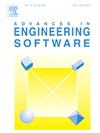钢-混凝土组合梁的太阳热效应:大跨度桥梁的气象数据驱动分析
IF 5.7
2区 工程技术
Q2 COMPUTER SCIENCE, INTERDISCIPLINARY APPLICATIONS
引用次数: 0
摘要
为了研究太阳辐射温度对大跨度桥梁钢-混凝土组合梁的影响,提出了一种基于气象参数的温度分析方法。首先,基于热传导原理和有限元计算理论,建立了精确的热分析模型;利用实测数据验证了模型的准确性。随后,在分析历史气象资料的基础上,计算出复合梁温差的代表值。该计算方法将有限元温度场模型与广义极值分布函数相结合。最后,将模拟的太阳辐射温度场应用于该大跨度桥梁的整体有限元模型。然后评价了太阳辐射温度效应对大跨度桥梁的综合影响。结果表明,有限元分析结果与实测值吻合较好。组合梁竖向正温差最大值的50年回归期代表值(Td)为17.613℃。在运行阶段,温度荷载在组合梁混凝土桥面产生的压应力超过车道荷载的两倍。通过对7种不同荷载效应组合的分析,确定了最不利荷载效应组合对桥梁结构的影响。这为桥梁设计和评估提供了重要参考。该研究为理解和预测大跨度桥梁的温度响应提供了一种新的方法。为实现桥梁健康监测的轻量化目标提供了理论基础和技术支持。本文章由计算机程序翻译,如有差异,请以英文原文为准。
Solar-induced thermal effects on steel-concrete composite beams: A meteorological data-driven analysis for long-span bridges
To investigate the effects of solar radiation temperature on steel-concrete composite beams in long-span bridges, a temperature analysis method based on meteorological parameters is proposed. First, an accurate thermal analysis model was established based on the principles of heat conduction and finite element computation theory. The model’s accuracy was validated using measured data. Subsequently, the representative values of temperature differences for the composite beam were calculated based on the analysis of historical meteorological data. The calculation method integrated the finite element temperature field model with the generalized extreme value distribution function. Finally, the simulated solar radiation temperature field was applied to the overall finite element model of the long-span bridge. The comprehensive influence of solar radiation temperature effects on long-span bridges was then evaluated. The results indicate that the finite element analysis results are in good agreement with the measured values. The 50-year return period representative value (Td) for the maximum vertical positive temperature difference in the composite beam is 17.613 °C. The compressive stress induced in the concrete bridge deck of the composite beam by temperature loads during the operational phase exceeds twice that caused by lane loads. By analyzing seven different load effect combinations, the impact of the most unfavorable load effect combination on the bridge structure was determined. This provides an important reference for bridge design and assessment. This research offers a novel method for understanding and predicting the temperature response of long-span bridges. Additionally, it provides theoretical foundations and technical support for achieving the lightweight goals of bridge health monitoring.
求助全文
通过发布文献求助,成功后即可免费获取论文全文。
去求助
来源期刊

Advances in Engineering Software
工程技术-计算机:跨学科应用
CiteScore
7.70
自引率
4.20%
发文量
169
审稿时长
37 days
期刊介绍:
The objective of this journal is to communicate recent and projected advances in computer-based engineering techniques. The fields covered include mechanical, aerospace, civil and environmental engineering, with an emphasis on research and development leading to practical problem-solving.
The scope of the journal includes:
• Innovative computational strategies and numerical algorithms for large-scale engineering problems
• Analysis and simulation techniques and systems
• Model and mesh generation
• Control of the accuracy, stability and efficiency of computational process
• Exploitation of new computing environments (eg distributed hetergeneous and collaborative computing)
• Advanced visualization techniques, virtual environments and prototyping
• Applications of AI, knowledge-based systems, computational intelligence, including fuzzy logic, neural networks and evolutionary computations
• Application of object-oriented technology to engineering problems
• Intelligent human computer interfaces
• Design automation, multidisciplinary design and optimization
• CAD, CAE and integrated process and product development systems
• Quality and reliability.
 求助内容:
求助内容: 应助结果提醒方式:
应助结果提醒方式:


